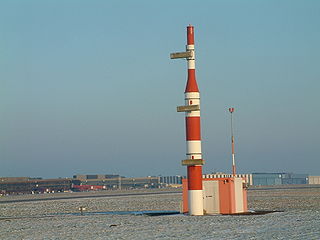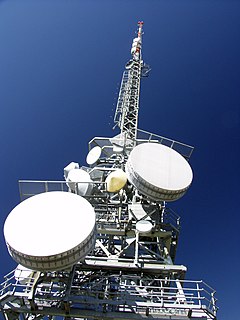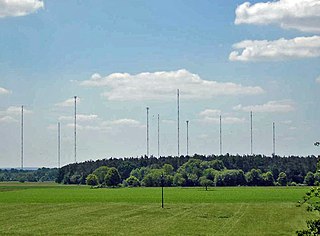
Fixed-satellite service is – according to article 1.21 of the International Telecommunication Union's (ITU) Radio Regulations (RR) – defined as A radiocommunication service between earth stations at given positions, when one or more satellites are used; the given position may be a specified fixed point or any fixed point within specified areas; in some cases this service includes satellite-to-satellite links, which may also be operated in the inter-satellite service; the fixed-satellite service may also include feeder links for other space radiocommunication services.
An amateur radio satellite is an artificial satellite built and used by amateur radio operators. It forms part of the Amateur-satellite service. These satellites use amateur radio frequency allocations to facilitate communication between amateur radio stations.

Aeronautical radionavigation service is – according to Article 1.46 of the International Telecommunication Union's (ITU) Radio Regulations (RR) – defined as "A radionavigation service intended for the benefit and for the safe operation of aircraft."
Mobile service is – in line to ITU Radio Regulations – a radiocommunication service between mobile and land stations, or between mobile stations (CV).

Mobile-satellite service is – according to Article 1.25 of the International Telecommunication Union's Radio Regulations – "A radiocommunication service

In telecommunications, a fixed service is a radiocommunication service between specified fixed points.

Space operation service is – according to Article 1.23 of the International Telecommunication Union's (ITU) Radio Regulations (RR) – defined as «A radiocommunication service concerned exclusively with the operation of spacecraft, in particular space tracking, space telemetry and space telecommand. These functions will normally be provided within the service in which the space station is operating.»

Standard frequency and time signal service is – according to Article 1.53 of the International Telecommunication Union's (ITU) Radio Regulations (RR) – defined as «A radiocommunication service for scientific, technical and other purposes, providing the transmission of specified frequencies, time signals, or both, of stated high precision, intended for general reception.»

Space research service is – according to Article 1.55 of the International Telecommunication Union's (ITU) Radio Regulations (RR) – defined as «A radiocommunication service in which spacecraft or other objects in space are used for scientific or technological research purposes.»

Land mobile-satellite service is – according to Article 1.27 of the International Telecommunication Union's (ITU) Radio Regulations (RR) – defined as «A mobile-satellite service in which mobile earth stations are located on land.»
A maritime mobile service is a mobile service between coast stations and ship stations, or between ship stations, or between associated on-board communication stations. The service may also be used by survival craft stations and emergency position-indicating radiobeacon stations.

Maritime mobile-satellite service is – according to Article 1.29 of the International Telecommunication Union's Radio Regulations (RR) – "A mobile-satellite service in which mobile earth stations are located on board ships; survival craft stations and emergency position-indicating radiobeacon stations may also participate in this service", in addition to serving as navigation systems.

Aeronautical mobile service is – according to Article 1.32 of the International Telecommunication Union's (ITU) Radio Regulations (RR) – defined as "A mobile service between aeronautical stations and aircraft stations, or between aircraft stations, in which survival craft stations may participate; emergency position-indicating radiobeacon stations may also participate in this service on designated distress and emergency frequencies."

Aeronautical mobile-satellite service is – according to Article 1.35 of the International Telecommunication Union's (ITU) Radio Regulations (RR) – defined as «A mobile-satellite service in which mobile earth stations are located on board aircraft; survival craft stations and emergency position-indicating radiobeacon stations may also participate in this service. . »

Aeronautical mobile (R) service is – according to Article 1.33 of the International Telecommunication Union's (ITU) Radio Regulations (RR) – defined as «An aeronautical mobile service reserved for communications relating to safety and regularity of flight, primarily along national or international civil air routes.»

Aeronautical mobile (OR) service is – according to Article 1.34 of the International Telecommunication Union's (ITU) Radio Regulations (RR) – defined as «An aeronautical mobile service intended for communications, including those relating to flight coordination, primarily outside national or international civil air routes.»

Aeronautical mobile-satellite (R)° service is – according to Article 1.36 of the International Telecommunication Union's (ITU) Radio Regulations (RR) – defined as «An aeronautical mobile-satellite service reserved for communications relating to safety and regularity of flights, primarily along national or international civil air routes.»

Aeronautical mobile-satellite (OR)°° service is – according to Article 1.37 of the International Telecommunication Union's (ITU) Radio Regulations (RR) – defined as «An aeronautical mobile-satellite service reserved for communications relating to safety and regularity of flights, primarily outside national or international civil air routes.»
Radiodetermination-satellite service is – according to Article 1.41 of the International Telecommunication Union's (ITU) Radio Regulations (RR) – defined as «A radiocommunication service for the purpose of radiodetermination involving the use of one or more space stations. This service may also include feeder links necessary for its own operation.»

Broadcasting-satellite service is – according to Article 1.39 of the International Telecommunication Union's (ITU) Radio Regulations (RR) – defined as «A radiocommunication service in which signals transmitted or retransmitted by space stations are intended for direct reception by the general public. In the broadcasting-satellite service, the term “direct reception” shall encompass both individual reception and community reception.»












